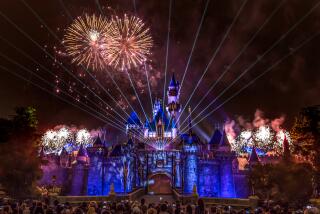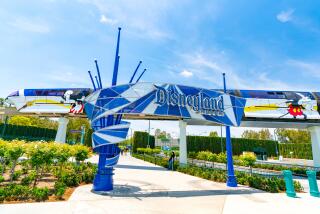How to Cut Amusement Park Costs
- Share via
Why are there more complaints than usual this year about the cost of visiting big amusement parks? It’s “totally outrageous,” writes one Whittier woman whose day at Disneyland for her family of five cost $311.50. “It’s obvious,” she comments, “that (they) are in a moneymaking business.”
Indeed they are. Corporations don’t run parks as a public service. At the same time, consumers don’t have to go. This is recreation, not necessity.
But that’s too simplistic. There may indeed be some excessive costs, and consumers could start protesting or rejecting them. At the very least, they could buy more wisely.
Examining the rich collection of parks in just one area--Los Angeles--one doesn’t find entrance fees low at $22 to almost $26. The usual response to such a complaint is comparison to other entertainments. Movies are $6.50 for 90 minutes (an average park stay is 8 hours); “tickets to a Rams game are $25,” says Bob Gault, Disneyland’s director of park operations, “and a concert is $50, $100, even $200.”
There are some price oddities: Although most parks have somewhat lower prices ($16-$20) for children under 12, Magic Mountain’s $11 child price is actually more restrictive, applying to “kids under 48 inches,” usually a 7- or 8-year-old. Magic Mountain, known as a “heavy-metal ride park,” is already a teen hangout; a $23 charge for still-small children discourages families further.
“It has to do with the number of rides they can get on,” explains Magic Mountain spokesman Courtney Simmons--in the case of Magic Mountain, all but one.
But do 7-year-olds really go on all the big roller coasters, the spinning, looping, 360-degree upside-down rides, the 10-story “FreeFall?” And should they?
In terms of overall expense, even the adult admission is the least of it--usually only “half of what you spend,” estimates Knott’s spokesman Stuart Zanville. The rest goes for food, merchandise, games and arcades, “in that order.” The Whittier family’s parking ($4 at most parks, to universal annoyance) and admission were 40%, or $127.50. Five rounds of drinks were $37.50, lunch was $21.50, popcorn, ice cream and candy were $17.50, dinner $32.50 and souvenir T-shirts $75.
Many people complain about the food prices, although if that’s an example, the actual meals seem reasonable. It’s the extras that tear it, and they’re hard to avoid. Many parks discourage, if not forbid, bringing in food--the danger of glass bottles, they claim--and may even inspect big bags and picnic hampers.
Moreover, there’s always a plethora of snack stands and a dearth of drinking fountains. Magic Mountain has 40 fountains in 111 entertainment acres (one every 3 acres), Disneyland 135 in 77 acres (1.7 per acre), Knott’s “over 100” in 38 acres (2.6 per acre). Now try to find them.
Such fountains could provide four of those five rounds of drinks. And one could probably get apples, bananas, certainly gum or suckers, past the food fuzz.
Visitors can also stiffen their spines against the souvenirs, although souvenir displays come at every turn. Many parks start and end with a gantlet of stores, and some rides, like Knott’s Dinosaur Kingdom, even exit riders directly into a gift shop. For all the people who like to buy mementos, or feel they have to, there are plenty who say they simply stay out of the stores, set strict limits ahead or tell children that they’re there “for the park,” period. It’s not a bad learning experience.
Most visitors--and columnists, this one included--are obsessed with getting the most for their money, particularly in the summer, when parks are crowded and a popular two-minute ride may have a one-hour wait. Many parks now post waiting times at ride entrances, sometimes (as at Disneyland) only when the time exceeds a half hour. No signs at all (Magic Mountain has almost none) are a problem, particularly when some of the line and all of the vehicles are hidden from view.
The time of year matters: Summer is definitely more crowded, hotter, and there are fewer promotions. But even local residents may have no choice. Their children are out of school, and their summer visitors want to visit the parks.
Time of day also matters--but less than one hopes. At Universal Studios, as everywhere, “the bulk of visitors come between 11 and 12,” says spokesman Joan Bullard. And mid-afternoon has the thickest crowds, with a peak between 3 and 4, says Zanville.
One might, therefore, catch a short window of opportunity in the mornings--the first couple of hours, when many parks have less than a third of their day’s population. Or a long window in the evening, when park populations are generally halved. Many, moreover, run shows, parades and fireworks in the evening, and people wanting to hit the rides may find them relatively free. Some visitors combine the two gambits, going morning and evening with a several-hour break in the afternoon or (the higher-priced spread) evening and then again the next morning.
As with any tourist spot, one should know ahead where one is going, drawing on available maps, brochures and advice. Limits must be set even with amusement.
More to Read
Inside the business of entertainment
The Wide Shot brings you news, analysis and insights on everything from streaming wars to production — and what it all means for the future.
You may occasionally receive promotional content from the Los Angeles Times.










